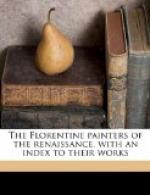The proportions of this small book forbid me to develop further a theme, the adequate treatment of which would require more than the entire space at my command. I must be satisfied with the crude and unillumined exposition given already, allowing myself this further word only, that I do not mean to imply that we get no pleasure from a picture except the tactile satisfaction. On the contrary, we get much pleasure from composition, more from colour, and perhaps more still from movement, to say nothing of all the possible associative pleasures for which every work of art is the occasion. What I do wish to say is that unless it satisfies our tactile imagination, a picture will not exert the fascination of an ever-heightened reality; first we shall exhaust its ideas, and then its power of appealing to our emotions, and its “beauty” will not seem more significant at the thousandth look than at the first.
My need of dwelling upon this subject at all, I must repeat, arises from the fact that although this principle is important indeed in other schools, it is all-important in the Florentine school. Without its due appreciation it would be impossible to do justice to Florentine painting. We should lose ourselves in admiration of its “teaching,” or perchance of its historical importance—as if historical importance were synonymous with artistic significance!—but we should never realise what artistic idea haunted the minds of its great men, and never understand why at a date so early it became academic.
[Page heading: GIOTTO AND VALUES OF TOUCH]
Let us now turn back to Giotto and see in what way he fulfils the first condition of painting as an art, which condition, as we agreed, is somehow to stimulate our tactile imagination. We shall understand this without difficulty if we cover with the same glance two pictures of nearly the same subject that hang side by side in the Florence Academy, one by “Cimabue,” and the other by Giotto. The difference is striking, but it does not consist so much in a difference of pattern and types, as of realisation. In the “Cimabue” we patiently decipher the lines and colours, and we conclude at last that they were intended to represent a woman seated, men and angels standing by or kneeling. To recognise these representations we have had to make many times the effort that the actual objects would have required, and in consequence our feeling of capacity has not only not been confirmed, but actually put in question. With what sense of relief, of rapidly rising vitality, we turn to the Giotto! Our eyes scarcely have had time to light on it before we realise it completely—the throne occupying a real space, the Virgin satisfactorily seated upon it, the angels grouped in rows about it. Our tactile imagination is put to play immediately. Our palms and fingers accompany our eyes much more quickly than in presence of real objects, the sensations varying constantly with the various projections represented, as of face, torso, knees; confirming in every way our feeling of capacity for coping with things,—for life, in short. I care little that the picture endowed with the gift of evoking such feelings has faults, that the types represented do not correspond to my ideal of beauty, that the figures are too massive, and almost unarticulated; I forgive them all, because I have much better to do than to dwell upon faults.




